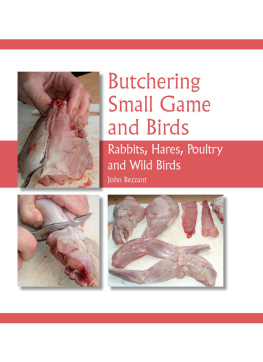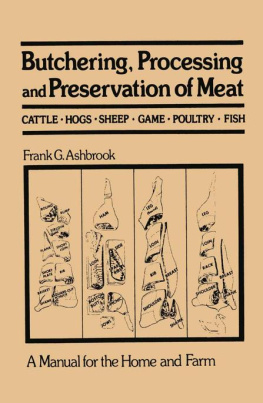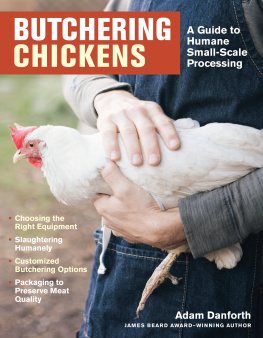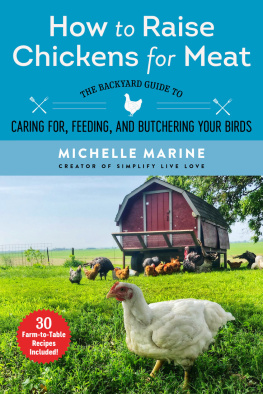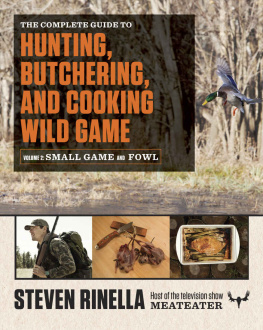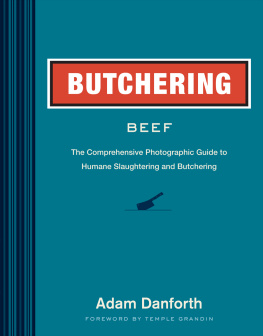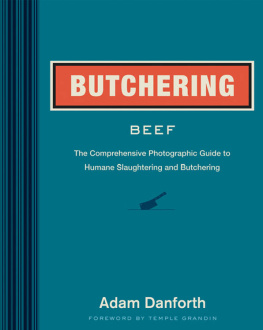
Butchering
Small Game
and Birds
Rabbits, Hares, Poultry
and Wild Birds
John Bezzant

THE CROWOOD PRESS
First published in 2012 by
The Crowood Press Ltd
Ramsbury, Marlborough
Wiltshire SN8 2HR
www.crowood.com
This e-book first published in 2014.
John Bezzant 2012
All rights reserved. No part of this publication may be reproduced or transmitted in any form or by any means, electronic or mechanical, including photocopy, recording, or any information storage and retrieval system, without permission in writing from the publishers.
British Library Cataloguing-in-Publication Data
A catalogue record for this book is available from the British Library.
ISBN 978 1 84797 969 8
Disclaimer
The author and the publisher do not accept any responsibility in any manner whatsoever for any error or omission, or any loss, damage, injury, adverse outcome, or liability of any kind incurred as a result of the use of any of the information contained in this book, or reliance upon it. If in doubt about any aspect of the butchery of small game and birds, readers are advised to seek professional advice.
Please note that if you intend to sell meat that you have butchered to the general public, there are numerous regulations to be followed, and you should contact your local environmental health department for advice. However, for the smallholder or private individual wishing to butcher small game or birds there are no restrictions or legal obligations other than the fact that if you were to cause undue suffering to an animal or bird during slaughter you would, of course, be causing animal cruelty would be liable to prosecution.
Contents
Introduction
The skilful butchering of small game and birds is not a magical art reserved for a chosen few, but a craft that can be learnt by any individual willing to master the basic techniques involved. However, you must first answer a question of utmost importance: are you the sort of person who can carry out butchery tasks? The beginning of the butchering process is the killing of an animal; in many cases the killing will be carried out at close quarters, using your bare hands. Obviously this is not something that everybody can do and there is no shame in that. Therefore, the first tool that you require is the kind of detached nature that means you can kill a small, furry animal that you have reared yourself, such as a rabbit or a bird, which you may have become fond of.
We will look at this aspect in much more detail in ; however, I have posed the question regarding your suitability for butchering tasks at this early stage so that you can think about it seriously before I start to introduce you to the nitty gritty of slaughtering small animals and birds. You also need to have a strong stomach that does not become queasy at the sight of blood or entrails, as it goes without saying that the butchering of small animals or birds will bring you face to face with both these bodily components.
Butchering is a very earthy, fundamental craft that, when skilfully performed, is very satisfying. However, a person who is squeamish will be hesitant which will, in turn, lead to a poorly performed butchery job, with the ruination of nutritious meat, meaning that an animal has died unnecessarily. So you see, the most important tool of all is, in fact, yourself: if you have the right frame of mind and a strong stomach, then all the skills you require to become a competent butcher of small game and birds can be learnt from the following pages. There is no need for a short course or for anybody to give you tuition; the skills required are very straightforward and it is perfectly possible for you to teach yourself.
I have taken an abundance of photos to help explain every single stage in fine detail, so there is a lot to read and much to look at, but if you study it closely you will soon become a very competent home butcher of small game and birds. I say home butcher because you can never hope to become a professional butcher; they are skilled men who undergo extensive training, followed by daily practice of their craft, so, although you will become a competent practitioner of the butchering craft, you will not quite match the standards of a professional. The work of the professional may be that bit finer than the work of the home butcher, but the home butcher can still produce a very fine carcase that is hygienic, well presented and cooks well, which is all that matters.

The amateur butcher can produce a very presentable carcase.

Killing birds that you have reared yourself, that you may have become fond of, is not an undertaking to be entered into lightly.
chapter one
Tools of the Trade
KNIVES
Knives are the most important item of your butchery kit; other items may be dispensed with, their use simply making the job easier and the finished product finer, but the knife is essential without it you simply cannot carry out the butchering of small game or birds. You can get away with just one knife if absolutely necessary, but it is far better to have a number, each one performing a specific task.
Price is not an indicator of a knifes usability; I have owned some very cheap knives that performed their task admirably and owned expensive knives that were next to useless. The first requirement of a good knife is that it feels comfortable in the hand; we all have hands of different shapes and sizes and what fits well into the bear-sized fist of a large man, will not fit as comfortably in the more delicate hand of a small woman. For this reason it is best to buy your knives from a local outlet, rather than over the internet, as you need to test the knife for its feel, prior to purchase. Remember, if the cheaper knife feels more comfortable than the expensive one, go for the cheaper option, even if the more expensive knife has a finer quality blade. The cheaper blade will actually do a better job if the fit of the haft is the more comfortable, for the simple reason that you will be better able to control and manipulate the blade.
Much has been written about the material from which the haft of a knife is made; the selection includes: natural wood, horn and a whole range of plastics. The concern often raised over smooth handles, such as wood, is that when a hand becomes slippery (when bloody for example) it can slip down the haft into contact with the sharp blade. The hand can indeed slip on a smooth haft, but it should not happen: one of the basic rules of butchering is to keep the hands clean at all times, if they become bloody or greasy then you halt operations and wash them. A professional butcher when asked what was the secret of good butchery answered: Clean hands. Clean hands are better able to control the tools of the trade, whereas dirty, blooded and greasy hands will never be in full control of the implements.

The points of the knife.
In the field, where it could be raining and muddy and where it is impossible to stay clean, a non-slip haft is of great value and could prevent a nasty accident; however, at the butchers bench, where proper standards of hygiene are being observed, non-slip hafts are not essential. Many amateur butchers like the feel of a wooden haft and, if that is your particular haft of choice, then select knives made of that material. My knives have rubber or resin hafts, simply because the most comfortable knives I have selected over the years happen to have rubber and resin hafts.
Next page
